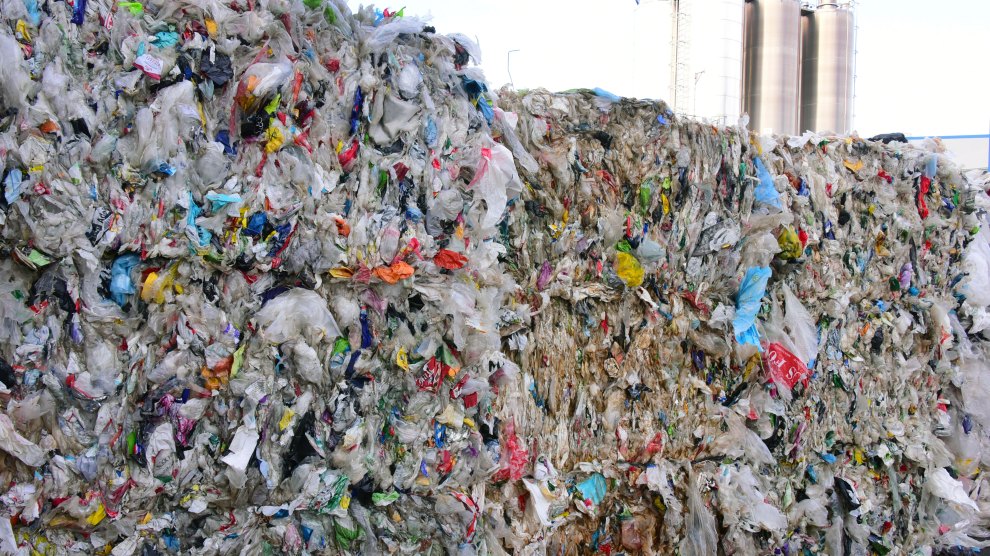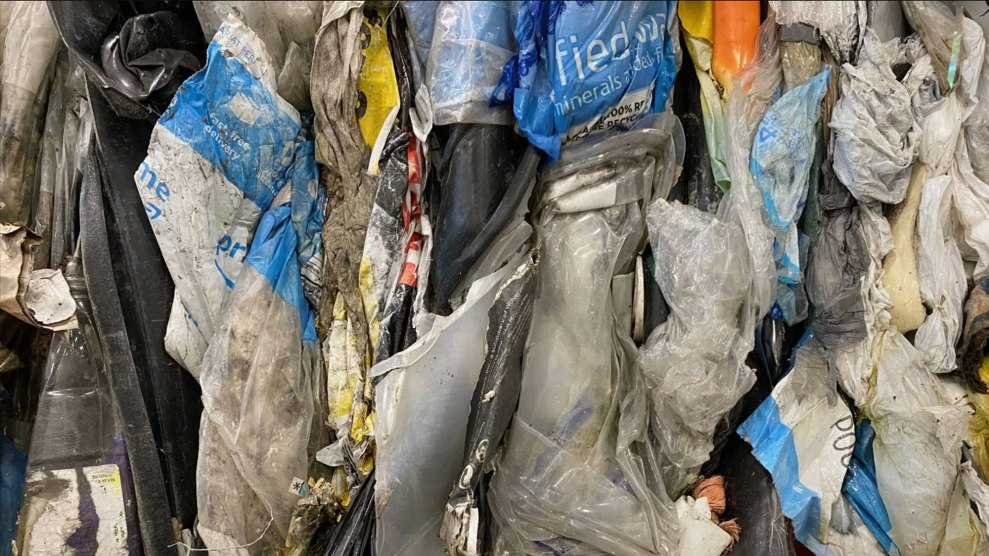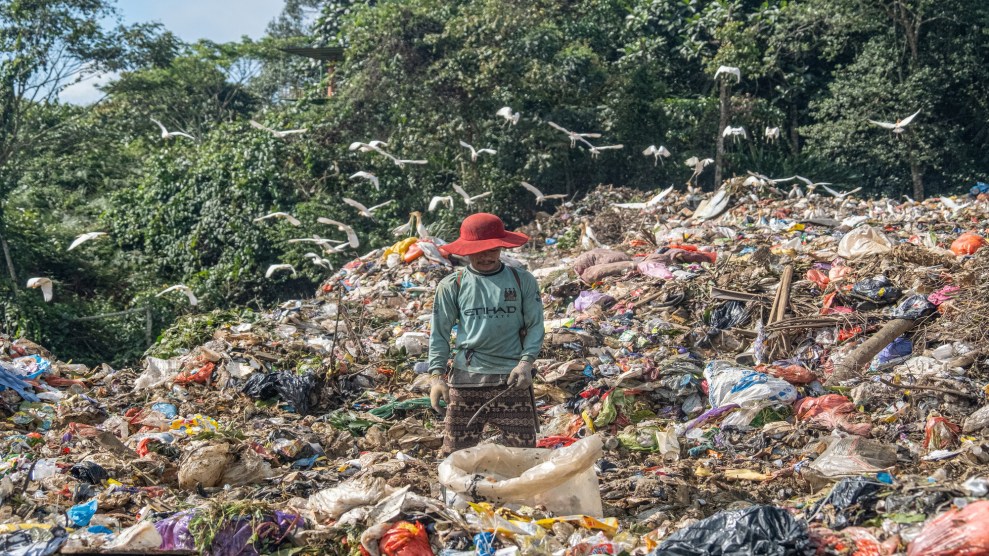
Bales of plastic waste await recycling at a German facility.Waltraud Grubitzsch/picture-alliance/dpa/AP
This story was originally published by the Wired and is reproduced here as part of the Climate Desk collaboration.
The plastics industry has long hyped recycling, even though it is well aware that it’s been a failure. Worldwide, only 9 percent of plastic waste actually gets recycled. In the United States, the rate is now 5 percent. Most used plastic is landfilled, incinerated, or winds up drifting around the environment.
Now, an alarming new study has found that even when plastic makes it to a recycling center, it can still end up splintering into smaller bits that contaminate the air and water. This pilot study focused on a single new facility where plastics are sorted, shredded, and melted down into pellets. Along the way, the plastic is washed several times, sloughing off microplastic particles—fragments smaller than 5 millimeters—into the plant’s wastewater.
Because there were multiple washes, the researchers could sample the water at four separate points along the production line. (They are not disclosing the identity of the facility’s operator, who cooperated with their project.) This plant was actually in the process of installing filters that could snag particles larger than 50 microns (a micron is a millionth of a meter), so the team was able to calculate the microplastic concentrations in raw versus filtered discharge water—basically a before-and-after snapshot of how effective filtration is.
Their microplastics tally was astronomical. Even with filtering, they calculate that the total discharge from the different washes could produce up to 75 billion particles per cubic meter of wastewater. Depending on the recycling facility, that liquid would ultimately get flushed into city water systems or the environment. In other words, recyclers trying to solve the plastics crisis may in fact be accidentally exacerbating the microplastics crisis, which is coating every corner of the environment with synthetic particles.
“It seems a bit backward, almost, that we do plastic recycling in order to protect the environment, and then end up increasing a different and potentially more harmful problem,” says plastics scientist Erina Brown, who led the research while at the University of Strathclyde.
“It raises some very serious concerns,” agrees Judith Enck, president of Beyond Plastics and a former US Environmental Protection Agency regional administrator, who wasn’t involved in the paper. “And I also think this points to the fact that plastics are fundamentally not sustainable.”
Kara Pochiro, spokesperson for the Association of Plastic Recyclers, notes in a statement provided to WIRED that recycling is regulated like any other industrial process in the US. “The recycling plant works closely with the local municipality to ensure the wastewater conforms with the capacity and quality required for the local sewer treatment facility,” Pochiro says. “When it is either economically or technically required, the recycling plant will install a water pre-treatment plant that partially treats the water in order to remove some of the burden from the municipal plant.”
The good news here is that filtration makes a difference: Without it, the researchers calculated that this single recycling facility could emit up to 6.5 million pounds of microplastic per year. Filtration got it down to an estimated 3 million pounds. “So it definitely was making a big impact when they installed the filtration,” says Brown. “We found particularly high removal efficiency of particles over 40 microns.”
But a critical caveat is that the team only tested for microplastics down to 1.6 microns. Plastic particles can get way smaller—like nanoplastics that are tiny enough to enter individual cells—and they grow much more numerous as they do. So this is likely a significant underestimate. And these researchers were finding a lot of particularly small particles. In two of the sample points, approximately 95 percent of the microplastics were under 10 microns, and 85 percent were under 5 microns. “It completely shocked me just how tiny the majority of them were,” says Brown. “But we easily could have found so many smaller than that.”
Depending on the recycling facility, that wastewater might next flow to a sewer system and eventually to a treatment plant that is not equipped to filter out such small particles before pumping the water into the environment. But, says Enck, “some of these facilities might be discharging directly into groundwater. They’re not always connected to the public sewer system.” That means the plastics could end up in the water people use for drinking or irrigating crops.
The full extent of the problem isn’t yet clear, as this pilot study observed just one facility. But because it was brand-new, it was probably a best-case scenario, says Steve Allen, a microplastics researcher at the Ocean Frontiers Institute and coauthor of the new paper. “It is a state-of-the-art plant, so it doesn’t get any better,” he says. “If this is this bad, what are the others like?”
These researchers also found high levels of airborne microplastics inside the facility, ready for workers to inhale. Previous research has found that recycled pellets contain a number of toxic chemicals, including endocrine-disrupting ones. Plastic particles can be dangerous to human lung cells, and a previous study found that laborers who work with nylon, which is also made of plastic, suffer from a chronic disease known as flock worker’s lung. When plastics break down in water, they release “leachate”—a complex cocktail of chemicals, many of which are hazardous to life.
Recycling a plastic bottle, then, isn’t just turning it into a new bottle. It’s deconstructing it and putting it back together again. “The recycling centers are potentially making things worse by actually creating microplastics faster and discharging them into both water and air,” says Deonie Allen, a coauthor of the paper and a microplastics researcher at the University of Birmingham. “I’m not sure we can technologically engineer our way out of that problem.”
Recycling is also a game of diminishing returns. A plastic bottle is easy enough to process, but you can only do that a few times before the material degrades too much to be recycled again. And as plastic products have gotten more complex—multilayered pouches for baby food, for instance—they’ve gotten harder to recycle. The industry’s literal dirty secret is that mountains of plastic waste are being shipped to economically developing countries, where the stuff is often burned in open pits, poisoning surrounding communities and sending still more microplastics and chemicals into the atmosphere. If recycling was actually effective in its current form, the industry wouldn’t have to keep producing exponentially more plastic—it’s now churning out a trillion pounds a year.
Still, researchers like Brown don’t think that we should abandon recycling. This new research shows that while filters can’t stop all the microplastics from leaving a recycling facility, they at least help substantially. “I really don’t want it to suggest to people that we shouldn’t recycle, and to give it a completely negative reputation,” she says. “What it really highlights is that we just really need to consider the impacts of the solutions.”
Scientists and anti-pollution groups agree that the ultimate solution isn’t relying on recycling or trying to pull trash out of the ocean, but massively cutting plastic production. “I just think this illustrates that plastics recycling in its traditional form has some pretty serious problems,” says Enck. “This is yet another reason to do everything humanly possible to avoid purchasing plastics.”












